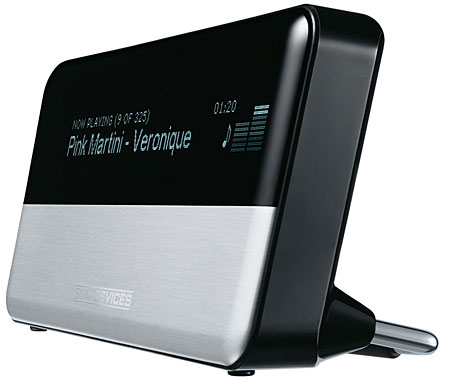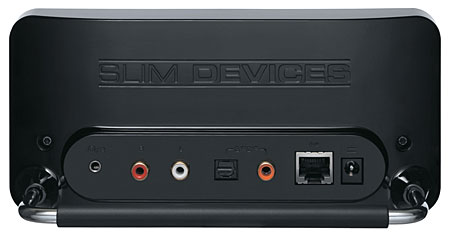| Columns Retired Columns & Blogs |
Slim Devices Squeezebox WiFi D/A processor
As readers of the Stereophile eNewsletter will be aware, the twin subjects of distributing music around my home and integrating my iTunes library of recordings into my high-end system have occupied much of my attention the past year. I bought an inexpensive Mac mini to use as a music server, using an Airport Express as a WiFi hub, which worked quite well, but my big step forward was getting a Squeezebox. I described this slim device in the mid-March and mid-April eNewsletters; I urge readers to read those reports to get the full background on this impressive device. In addition, the forums and Wiki pages on the Slim Devices website offer a wealth of information on getting the most from a Squeezebox.
Footnote 1: A number of companies, such as Red Wine Audio and Bolder Cable, now offer modifications and upgraded power supplies for the Squeezebox. Red Wine also offers a battery supply for the Squeezebox.

To summarize, the Squeezebox is the size and shape of a digital alarm clock, finished in white or black, with a turquoise fluorescent 320x32-pixel display running its full width, and once networked to a server, allows music files to be played on a conventional audio system. The Ethernet version costs $249, the WiFi/Ethernet version $299. It offers both digital and analog outputs, and has a volume control, a headphone jack, and a coaxial digital as well as an optical digital output. Its audio circuitry is based on a 24-bit DAC (a Burr-Brown PCM1748), with regulated power supplies used for the DAC and output amplifier stages. Significantly, the S/PDIF output and DAC clocks are driven directly by two dedicated crystal oscillators running at fixed frequencies. An outboard D/A processor driven by the Squeezebox thus doesn't lose lock between songs, and should enjoy the benefit of lower clock jitter. Most important, the Squeezebox's remote control lets you select songs from your listening seat.
The Squeezebox owner needs to install the SlimServer software on the computer being used as a server. This open-source software is available in versions for Windows XP, Mac OSX, and Linux, and it recognizes the iTunes library. SlimServer handles a wide range of file formats, including MP3, AAC, AIF, WAV, ALC, Vorbis, Windows Media, and FLAC. However, it can't handle DRM-wrapped, AAC-encoded songs you've downloaded from iTunes. The Squeezebox also offers native Windows Media support, not only providing playback of WMA files but allowing many Internet radio stations to be decoded as well.
When SlimServer serves compressed audio files to the Squeezebox, it decodes them on the fly from whatever file format they're in and sends uncompressed PCM over the WiFi link. If the WiFi network has problems handling the data rate, SlimServer can be set to compress the audio on the fly before transmission, using the popular FLAC lossless format, which runs at half the broadcast bit rate as PCM—or even a lossy compression such as LAME MP3, which reduces the basic bit rate to around 128kbps. The Squeezebox's native FLAC and MP3 decoders reconvert compressed data to PCM before serving them to the SB's DAC and S/PDIF circuits.
Sound quality
I set up the WiFi version of the Squeezebox in my listening room, powered by its wall-wart supply. I connected its optical S/PDIF output with a 1.5m length of AudioQuest's OptiLink-5 quartz-fiber TosLink cable first to my Mark Levinson No.30.6 D/A processor, then to a Benchmark DAC 1. Sitting in my listening chair, I browsed my iTunes library on the distant Mac using the remote's Left, Right, Up, and Down buttons, found something I liked, and pressed Play. Music came from the speakers, and pressing the remote's Now Playing button displayed the song's metadata on the SB's screen.
There was a cleanness to the sound that I didn't get from the Airport Express's digital output feeding the same D/A. Comparing the original CD on the Ayre C-5xe disc player, its digital output driving the Levinson DAC via a 1m DH Labs AES/EBU link, with SlimServer feeding an Apple Lossless–encoded file to the Squeezebox with its digital output feeding the Levinson via the AudioQuest OptiLink-5, I was hard-pressed to hear much of a difference. Perhaps there was an increased sense of authority to the sound of the CD played by the Ayre used as a transport, a better sense of extended low frequencies—but when I'm not listening seriously, the difference is irrelevant. Even when I am listening seriously, I have to strain to hear that difference (as long as I'm not listening to lossy-compressed files).
But it is the Squeezebox's performance via its analog outputs that will interest many readers. I hooked it up to the Levinson preamp with Di Marzio unbalanced interconnect and level-matched (to better than 0.05dB at 1kHz) the SB's output to that of the Benchmark DAC 1 fed by the SB's digital output using the preamp's Input Level Offset function.
Listening first to the Squeezebox in full D/A mode, with its volume control bypassed—the volume control operates in the digital domain, thus loses resolution at settings much below its maximum—the sound was impressively clean. It was only when I compared it directly to the Benchmark that I became aware of some slight shortfalls in its sound quality. Specifically, the low frequencies seemed both less weighty and less extended. Playing ALC files I'd ripped from Van Morrison's Live at the Grand Opera House Belfast (Mercury 422-818-336-2), for example, the bass guitar on "Haunts of Ancient Peace" sounded a little bloated compared with the Benchmark, which itself doesn't dig as deep into the Stygian depths as my reference Levinson DAC.

The midrange and treble also seemed a little more congested, the "silences between the notes" not having the clear definition I have come to appreciate from the Benchmark. On my own recording of Minnesotan choir Cantus performing Sir Charles Stanford's Songs of the Sea (from their forthcoming There Lies the Home CD), there seemed a little less spatial separation between the baritone soloist and the choir, spread out in an arc behind him. At the choral climaxes there was a bit more of an aggressive edge from the Squeezebox's analog outputs than there was from the Benchmark fed from the Squeezebox's digital output.
My final series of comparisons were with the Pioneer DV-578A SACD/CD player I bought a year or so back to use as a low-cost ($160) disc-player reference. Playing CDs on the Pioneer that I had also ripped to my iTunes library as ALC files, and comparing them with the Squeezebox's analog outputs, again with levels matched at 1kHz, I must say that there wasn't much of a difference between the two units. Both sounded more congested in the treble than my higher-cost references, and neither offered the ultimate in bass extension or definition—but neither offered sound that offended. Overall, their sins were of omission rather than commission.
Summing up
While the Slim Devices Squeezebox with stock power supply (footnote 1) offers generally good performance from its analog outputs, it was the sound it produced driving a high-end DAC from its digital output that persuaded me to purchase the review sample. While I still turn to a dedicated disc player for the highest sound quality, much of my listening to music is done while I'm doing something else—writing, editing, reading—and for that, the Squeezebox has become my primary source. As I wrote in the mid-April eNewsletter, "physical discs seem so 20th century!" Very highly recommended.
Footnote 1: A number of companies, such as Red Wine Audio and Bolder Cable, now offer modifications and upgraded power supplies for the Squeezebox. Red Wine also offers a battery supply for the Squeezebox.
- Log in or register to post comments




































